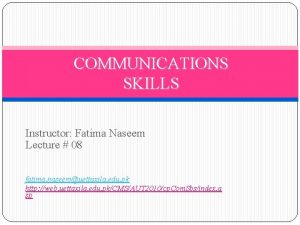Analysis of Visual Data Teacher Name Mahvish Fatima







- Slides: 7

Analysis of Visual Data Teacher Name: Mahvish Fatima Kashif

� “Experiences and meanings become tangible through visual representation and may be understood in ways that other conventional forms of communication may not necessarily allow. ” Liebenberg, 2009.

� Visual Elicitation is a kind of social exchange…. � It is the missing link between the differing realities of research and participant. � Photo elicitation is using photographs or other visual mediums in an interview to generate verbal discussion to create data and knowledge. Different layers of meaning can be discovered as this method evokes deep emotions, memories, and ideas. Photo elicitation interviews contribute to trustworthiness and rigor of the findings through member checking.

Examples of Visual Methods � Photographs � Video � Maps � Illustrations � Participant-constructed images act as communication tools. � Images are representations of how subjects interpret their contexts, relationships, decisions, and realities.

Strategies for analyzing observations � Choronology: describe what was observed chronologically overtime, to tell the story from the beginning to the end � Key events: describing critical incidents or major events, not necessarily in order of occurrence but in order of importance � Various settings: describe various places, sites, settings, or locations in which events/behaviours of interest happen

� People: describing important processes(e. g. Control, recruitment, decision-making, socialization, communication) � Issues: Illuminating key issues – how did participants change

Thank You











